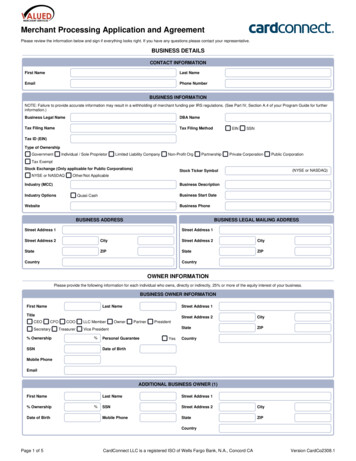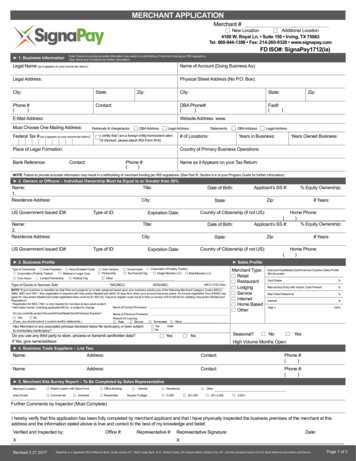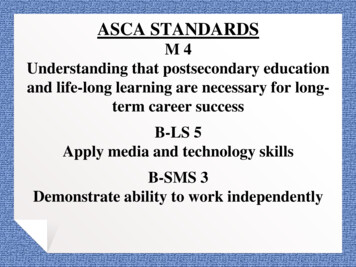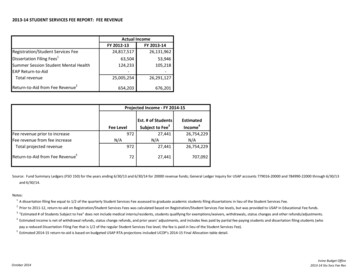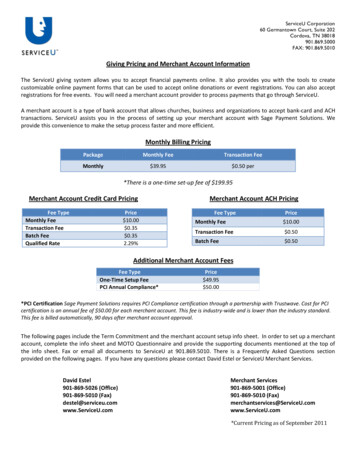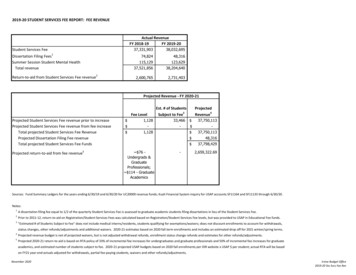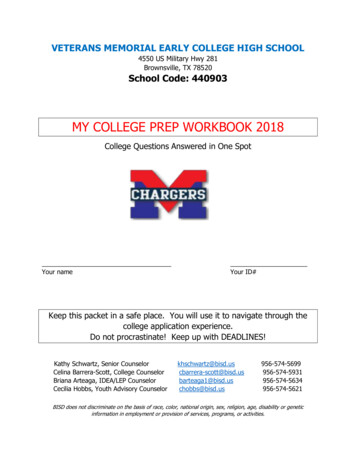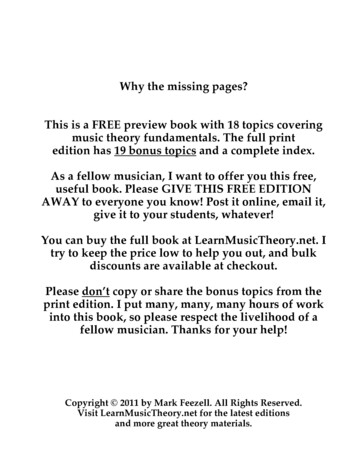
Transcription
Why the missing pages?This is a FREE preview book with 18 topics coveringmusic theory fundamentals. The full printedition has 19 bonus topics and a complete index.As a fellow musician, I want to offer you this free,useful book. Please GIVE THIS FREE EDITIONAWAY to everyone you know! Post it online, email it,give it to your students, whatever!You can buy the full book at LearnMusicTheory.net. Itry to keep the price low to help you out, and bulkdiscounts are available at checkout.Please don’t copy or share the bonus topics from theprint edition. I put many, many, many hours of workinto this book, so please respect the livelihood of afellow musician. Thanks for your help!Copyright 2011 by Mark Feezell. All Rights Reserved.Visit LearnMusicTheory.net for the latest editionsand more great theory materials.
Music TheoryFundamentalsHigh-Yield Music Theory, vol. 1Mark FeezellLearnMusicTheory.net
iiiTABLEOF CONTENTSForeword: What is high-yield music theory? . v!Chapter 1: Music Notation .7!1.1 Staves and Clefs. 8!1.2 The Chromatic Scale and the Piano . 10!1.3 All About Octaves . 12!1.4 Rhythmic Values . 14!1.5 Time Signatures in Simple Meter . 16!1.6 Compound and Asymmetric Meter . 18!1.7 Tuplets/Grouplets . 20!1.8 Repeat Signs and Repeated Sections. 22!1.9 Dynamics, Articulations, Slurs, Tempo Markings . 24!1.10 Summary of Notation Guidelines. 26!Chapter 2: Major and Minor Scales and Keys .29!2.1 Major Scales . 30!2.2 The Circle of Fifths . 32!2.3 Learning Major Key Signatures . 33!2.4 Minor Scales: Two Roads . 34!2.5 Key Signatures Self-Study Tips . 36!2.6 Scale Degree Names. 38!2.7 Major and Natural Minor Scales for Piano . 39!Chapter 3: Intervals and Transposition .41!3.1 Introduction to Intervals . 42!3.2 Mastering Intervals 1 . 44!3.3 Mastering Intervals 2 . 46!3.4 Transposition . 48!Chapter 4: Triads and Seventh Chords .51!4.1 Introducing Triads . 52!4.2 The Major Triads: Spell Them Quickly. 54!4.3 Spelling Triads in Four Steps . 55!4.4 Seventh Chords. 56!4.5 Common Chord Reference Chart . 57!4.6 Basic Lead Sheet Symbols . 58!Chapter 5: Introduction to Harmonic Analysis .59!5.1 Texture in Music. 60!5.2 Roman Numerals. 62!5.3 Harmonic progression . 64!5.4 Harmonic Analysis 1: Homophonic Texture. 66!5.5 Nonchord Tones 1 . 68!5.6 Nonchord Tones 2: Suspensions . 70!5.7 Second Inversion Triads . 71!5.8 Harmonic Analysis 2: Polyphonic Texture. 73!Appendices: Solfège and Rhythmic Syllables .75!Appendix 1: Solfège Syllables . 76!Appendix 2: Rhythmic Counting Syllables . 78!Postlude: Review, Resources, Index .81!Remember-Forever Review: Music Theory Fundamentals. 82!Music Theory Fundamentals: More Resources . 85!Index . 86
vForeword:WHAT ISPhilosophyHIGH-YIELD MUSIC THEORY?The core principles guiding high-yield music theory are:1. Assume no prior knowledge.2. Build one concept at a time.3. Get to the POINT!VolumesThe latest editions of this study reference are available at LearnMusicTheory.net.Eventually there will be multiple volumes, covering Music TheoryFundamentals; Harmony; Jazz, Pop, and Contemporary Music Theory(including Twentieth-Century Music); and Form in Music.FormatThe format for each volume is consistent:1. The left column lists terms to help you organize your study and findtopics quickly.2. Bold indicates key concepts.3. Each volume ends with a Remember-Forever Review and MoreResources.Students: how touse this guideStudents can read it before or after your primary text for a music theory course. use it as an efficient review before entrance exams, barriers, etc. use it as a theory reference book by looking up terms in the index. use it to quiz or tutor your fellow students. check out the great resources listed under “More Resources.”Teachers: how touse this guideTeachers can use it as a class lecture outline along with your favorite theory text. use it as a review guide after presenting the material with yourfavorite text. use the Remember-Forever Review section before final exams. require students to purchase one or more volumes for extra study. use it as a primary textbook alongside your favorite workbook ormusic anthology.
Chapter 1MUSIC NOTATION1.1 Staves and Clefs: elements of music, staff, note names, clef, treble clef, bass clef, ledger lines,grand staff, C clefs, alto clef, tenor clef1.2 The Chromatic Scale and the Piano: piano keyboard diagram, pattern of piano keyboard, halfstep, accidentals, whole step, natural half steps, enharmonic notes, scale, chromatic scale1.3 All About Octaves: octave, middle C, ledger lines between the staves, American Standard octavedesignations, Helmholtz octave designations, ottava, quindicesima, octave clef1.4 Rhythmic Values: duration, rhythmic value, rhythm, notehead, stems, flags, beams, rests, ties,augmentation dots, double-dotted notes1.5 Time Signatures in Simple Meter: beat, measure, bar, barline, time signature, beat unit, simpletime signature, duple, triple, quadruple, beat division and subdivision, cut time, alla breve, commontime, anacrusis, downbeat, strong beat, weak beat, stress patterns1.6 Compound and Asymmetric Meter: compound time signatures, tempo and meter, asymmetrictime signatures, anacrusis and stress patterns in compound meter, summary of time signatures1.7 Tuplets/Grouplets: tuplets, grouplets, triplets, quintuplets, sextuplets, septuplets, brackets,duplets and quadruplets (compound time signatures), duplets and quadruplets as dotted values1.8 Repeat Signs and Repeated Sections: simple repeats, first and second endings, D.C. al fine, D.S.al coda, D.S. al fine, D.C. al coda, repeated beat, repeated measure, two-measure repeat1.9 Dynamics, Articulations, Slurs, Tempo Markings: dynamics, articulations, slurs, bowings,fermatas, breath marks, caesura/grand pause, crescendo, diminuendo, decrescendo, tempo, BPM,M.M., Italian tempo indications1.10 Summary of Notation Guidelines: staves, system, clefs, noteheads, accidentals, stems, beams,rhythm and meter, key signatures
8LearnMusicTheory.net High-Yield Music Theory, Vol. 1: Music Theory FundamentalsSection 1.1STAVESCLEFSANDElements ofmusicThe fundamental elements of music are pitch (the highness/lowness of thenotes), duration (how long the notes last), timbre (overall type of soundsuch as trumpet versus clarinet), and dynamics/loudness. Some authorsadd frequency (the speed of the physical vibration making the sound) andtexture (see 5.1 Texture in Music).StaffA staff (plural: staves) uses five parallel lines to notate (write down) thepitch aspect of music. Higher-pitched notes are written higher on the staff.Staff lines are numbered 1 to 5, starting from the bottom line. Note namesfrom low to high are the letters A, B, C, D, E, F, G, then repeating A, B, C Note namesClefTreble clefA clef indicates which note names go on which lines (and spaces betweenthe lines) on the staff. Clefs are written at the start of the staff. Treble clefdesignates the second line from the bottom as G. The lines in treble clefrepresent the pitches E, G, B, D, and F. The spaces are F, A, C, and E.stafftreble clef& wG, so.w wwwwwww w w wD Ew w& w w w ww w& w w wBass clefGBDF G line 1F G A B C D EF-A-C-E spells faceEvery Good Boy Does Finelines: Eline 5Fspaces: DF A CEGBass clef designates the fourth line from the bottom as F. The lines in bassclef represent the pitches G, B, D, F, and A. The spaces are A, C, E, and G.staff?wbass clefw w w wwwww w w wF, so. F?G A Bw wwwwGood Boys Do Fine Alwayslines: G BDFAC?D E F G A BAll Cars Eat GasAll Cows Eat Grasswwww w wspaces: FA CEGB
Chapter 1: Music NotationLedger linesLedger lines are small lines that extend the staff higher and lower. Theycan be used with any clef. Ledger lines belong to a single note; they neverconnect to ledger lines for surrounding notes.C DB www w& ww w wC BEDwFwww?w w w wE D CBAGA grand staff is a treble clef staff and bass clef staff connected with a brace.Piano music uses a grand staff, along with instruments such as harp andmarimba. Sometimes vocal (choir) music is also notated using a grand staff.bracegrandstaffGBDG BDFADF A CFA CEGBAll C clefs indicate where C is on the staff. Alto clef is a C clef centered onthe third line from the bottom, designating it as C. Parts for the viola (astring instrument in the violin family) almost always use alto clef.staffBalto clefwC, so.Tenor ClefE Gw wwww ww wwww wFww& w w www?ww wEC clefsAlto clefCledger linesAGrand staff9w w wwwwww w w wEFGABCDEFGATenor clef is a C clef centered on the fourth line from the bottom,designating it as C. Bassoon and trombone music occasionally uses tenorclef, although both instruments more commonly read bass clef.staffBwtenor clefC, so.w wwwwww w w w wCDEFGABCDEF
10LearnMusicTheory.net High-Yield Music Theory, Vol. 1: Music Theory FundamentalsSection 1.2THE CHROMATIC SCALEPattern of thepiano keyboardThis section uses the piano, but the concepts apply to other instrumentsand voice also. The piano repeats a pattern: groups of two black keysalternate with groups of three. Every white key just to the left of a group oftwo black keys is labeled as C. After G, the letter names start over with A.2 black keysCHalf stepNatural half stepsAccidentalsFlat, natural,sharpPIANOAND THEDE3 black keysFGA2 black keysBCDE3 black keysFGABA half step is the distance from one piano key to the next closest (whetherit happens to be white or black). E to F is a half step, because E and F arenext to one another. Similarly, B to C is a half step. E to F and B to C are theonly natural half steps because they use letter names without accidentals.The black keys use the letter of an adjacent white key plus a modifier calledan accidental. The most common accidentals are:1. b flat; one half step lower than (left of) a white key2. § natural; cancels other accidentals; indicates white notes on a piano3. # sharp; one half step higher than (right of) a white ic notes are different names for the same piano key. Forexample, the black key called C sharp is one half step above C, but also onehalf step below D. C sharp is enharmonic with D flat. White keys also haveenharmonic names: B raised one half step with a sharp is the white key C.
Chapter 1: Music NotationDouble flatDouble sharpsA double flat lowers a flat note by another half step, keeping the sameletter name. Double flats are thus two half steps lower than the white key(natural) note. Similarly, a double sharp (looks like an x) raises a sharpnote by another half step, keeping the same letter name. Double sharps aretwo half steps higher than the white key (natural) note.DbDºAll enharmonics11D#DCºDXC#CCbCXThe piano keyboard below shows all the enharmonic names for the �DXFbWhole stepA whole step is two half steps. For instance, for C up to D, the two halfsteps are C to C# and C# to D.ScaleA scale (from the Italian word for ladder) is a series of notes from low tohigh (or high to low) following some pattern of whole steps and half steps.A chromatic scale lists all the notes (white and black keys) in order, usuallyfrom C to the next C above or below. Chromatic scales use only half steps.Ascending chromatic scales use sharps for black piano keys. Descendingchromatic scales use flats for black piano keys.Chromatic scale&w #w w #w w w#www#www #wAscending chromatic scale (uses sharps for black keys)CC# DD# EFF# GG# AA# BC& w w bw w bw w bw w w bw w bw wDescending chromatic scale (uses flats for black keys)CBBbAAbGGbFEEbDDbC
12LearnMusicTheory.net High-Yield Music Theory, Vol. 1: Music Theory FundamentalsSection 1.3ALL ABOUT OCTAVESOctaveAn octave is the distance from a note up or down to the next note with thesame name. For example, from the pitch A up to the next A is one octave.Octaves span eight letter names: A-B-C-D-E-F-G-A 1-2-3-4-5-6-7-8.Middle CMiddle C is the C just to the left of center on the piano keyboard; it is nearthe “middle” of the piano. In treble clef, middle C is one ledger line belowthe staff. In bass clef, middle C is one ledger line above the staff. On C clefs,including alto clef and tenor clef, middle C is at the center of the clef sign.All of the notes below represent exactly the same piano key (middle C).middle Cmiddle C& w BwMiddle C on thegrand staffB wmiddle C? wmiddle CIn a grand staff, middle C is notated differently depending on whether it isin the treble or bass clef. Middle C is literally the “middle” ledger line, oneline below the treble clef and one line above the bass clef.middle C& w?Ledger linesbetween thestaveswLedger lines may occur between the staves to make it clear whether thenotes are in the treble clef (or right hand) part or bass clef (left hand) part. same pitchesin bass clef staffmelody in treble clef staff& w wmiddle C?ww &? wmiddle Cwww
Chapter 1: Music NotationAmericanStandard octavedesignations13In American Standard (or Scientific) Pitch Notation, The octaves arenumbered, with middle C being C4. Every C begins a new octave number,so the B just below C4 is B3, and the D just above C4 is D4. Accidentalsdon’t change the octave; B# 4 C5, and Cb5 B4.&?middle CC1wC2C3wwwC4w(C4)wwwC5C6C7Helmholtz octavedesignationsHelmholtz pitch notation is used widely in Europe and older sciencepublications. Middle C is c’ (read “one-line C”). Octaves are C,, (“subcontraC”); C, (“contra C”); C (“great C”); c (“small C”); c’ (“one-line C” MiddleC); c’’ (“two-line C”); c’’’ (“three-line C”); and c’’’’ (“four-line C”).OttavaThe ottava symbol (8va) raises a note by one octave, while the ottava bassa(8vb) lowers a note by one octave. Ottava always appears above the staff,and ottava bassa appears below the staff. Similarly, quindicesima (15ma)raises a note two octaves; quindicesima bassa lowers a note two octaves.Quindicesima“”&wottava: ÿ& w & w 8ve upquindicesima:Octave clef &w two 8ves up? w“‘ ? w Ÿ ottava bassa:? w 8ve downquindicesima bassa:?w two 8ves downThe octave clef lowers the music an octave; it is often used for tenor voice.&w &w‹ octave cleftreble clef
14LearnMusicTheory.net High-Yield Music Theory, Vol. 1: Music Theory FundamentalsSection 1.4RHYTHMIC VALUESDurationRhythmic valueRhythmDuration is how long a note lasts. A rhythmic value is a symbol indicatingrelative duration (see table below). A rhythm is a series of rhythmic values.Rhythmic valuesRhythmic values indicate relative duration, not absolute duration. Eachrhythmic value is half the duration of the next longer value. Shorter notevalues (64th notes, etc.) are also possible.breveWwwhole w whole half of a brevenotehalf noteetc. half half of a wholequarter half of a half note ORquarter one quarter of a wholequarterœnote8th half ofa quarter OR8th 8th ofa whole noteeighthnote œ16thnote œœœ32ndnote œ œ œ œ œ œ œ œ œ œ œ œ œ œ œ œ œ œ œ œ œ œ œ œ œ œ œ œ œ œ œ œNoteheadStemsFlagsBeamsThe oval part of the note is called the notehead. Notes shorter than wholenotes have a stem attached to the notehead. Notes shorter than quartershave flags or beams, depending on the rhythmic context (see 1.10Summary of Notation Guidelines). Eighth notes have one flag (or beam),sixteenth notes have two flags (or two beams), and so on. The position ofthe notehead on the staff indicates the pitch of the note.FlagStemee iq BeamNotehead(2 eighth notes with flags) (2 eighth notes beamed together)
Chapter 1: Music NotationRestsRests are similar to notes, but indicate lengths of silences. A breve rest istwice as long as a whole rest, a whole rest is twice as long as a half rest, andso on. Remember that a whole note looks like a “hole” in the ground.Úbreve wholeTies halfÓquarter eighth sixteenth thirty-secondŒ‰ A tie combines rhythmic values together. For example, two eighth notestied together make a rhythmic value equal to one quarter note. Ties connectnotes of the same pitch. Ties never connect rests.e( e qTieAugmentationdots (dottedrhythmic values)15andx( x( x( x qandq( q hetc.An augmentation dot on any note or rest adds half the duration. Therhythmic value is said to be “dotted.” For example, a dotted half noteequals a half note plus a quarter note, since a quarter note is half of a halfnote. Similarly, a dotted quarter note equals a quarter note plus an eighthnote, since an eighth note is half of a quarter note.h. (dotted half note) h q q q qq. (dotted quarter note) q e e e eDouble-dottednotesA second augmentation dot (if present), adds half the first dot’s value.Rhythmic values with two dots are “double-dotted.” For example, adouble-dotted half note equals a half note plus a quarter note (for the firstdot) plus an eighth note (half of a quarter note, for the second dot). Doubledotted notes are 1.75 times as long (1 0.5 0.25) as the undotted value.h. (double-dotted half note) h q eq. (double-dotted quarter note) q e x
16LearnMusicTheory.net High-Yield Music Theory, Vol. 1: Music Theory FundamentalsSection 1.5TIME SIGNATURESBeatMeasureBar, BarlineFinal barlinemeasure or bar& œ œ œ œBeat unit, Simpletime signatureSIMPLE METERA beat is a repeating musical pulse. Listeners sense the beat when they taptheir feet or clap their hands in time with the music. Musicians group beatsinto units called measures or bars. Every measure ends with a barline. Aspecial final barline indicates the end of the movement or piece.measure or barTime signatureINœ œ barline1234123œ œ 44 4 beats in each measure q gets one beatfinal barline4123œ œ 4Meters (that is, time signatures) with two beats per measure are duple,those with three beats are triple, and those with four beats are quadruple.Duple meter:12& 24 œ œbeats42 q2 getsbeatBeat division andsubdivisionœ œ A time signature (or meter signature) indicates how many beats there arein one measure and what rhythmic value gets one beat (this value is calledthe beat unit). For time signatures in simple meter, the top number is thenumber of beats in each measure, and the bottom number is the beat unit.Time signatures are not fractions, so there is no line between the numbers.& 44 œ œ œ œDuple, Triple,Quadruplemeasure or barTriple meter:123& 43 œ œ œbeats43 3q getsbeatQuadruple meter:1234& 44 œ œ œ œ44 4 beats q gets beatEach beat in simple meter divides into two equal beat divisions, or fourequal beat subdivisions. Below, one quarter note beat equals two eighthnotes or four sixteenth notes; see 1.4 Rhythmic Values.Beat units:12& 24 œ œBeat divisions:122& 4 œ œ œ œBeat subdivisions:122&4 œ œ œ œ œ œ œ œ
Chapter 1: Music NotationOther beat unitsCut timeAlla breveCommon timeThe bottom number in a simple time signature indicates the beat unit: twomeans half note, four means quarter, eight means eighth, and so on. Thefirst time signature below is also called cut time or alla breve. The secondtime signature is common in Baroque music; sometimes the eighth notesare written with flags instead of beamed together. The last time signature issometimes called common time.12 &2 222 2 beats h gets beat22 is sometimes writtenAnacrusisPickup measure17C1 2 33œ&8 œ œ38 3 beats e gets beat12344œœœœ&444 4 beats q gets beat44 is sometimes writtencAn anacrusis (or pickup measure) is a partial measure that begins somepieces. An anacrusis is often one beat long, but not always. If there is ananacrusis, the final measure will be shortened so that the anacrusis and thefinal, shortened measure together equal the length of one regular measure.& 44 œ1anacrusis(pickup)1234œ œ œ œ1234œ œ œ œ123œ œ œshortened final bar(because of the anacrusis)DownbeatStrong beatWeak beatThe downbeat is the first beat of each measure. The downbeat isfundamental and stable (a strong beat) because it initiates each new groupof beats. The last beat of each measure is unstable (a weak beat) because itpulls forward to the following measure. The last beat of a measure oftenseems to have more energy than the downbeat, because it propels therhythm forward to the more stable, stronger downbeat.Stress patternsThe following stress patterns for beats are common:1. Duple meters: Meters with two beats follow a STRONG-weak stresspattern for the two beats.2. Triple meters: Meters with three beats follow a STRONG-weak-weakstress pattern for the three beats.3. Quadruple meters: Meters with four beats follow a STRONGESTweak-STRONG-weak pattern for the four beats.
18LearnMusicTheory.net High-Yield Music Theory, Vol. 1: Music Theory FundamentalsSection 1.6COMPOUNDCompound timesignaturesASYMMETRIC METERANDBeats in compound time signatures divide into three division notes, nottwo. The top number indicates the number of division notes per measure.The bottom number indicates the division rhythmic value (not the beatunit). It takes three division notes (not two) to make one beat.12œ œ 6&8 œ œ œ œ œ œDecodingcompound timesignaturesOne beat e e e q.2 beats (Duple)A time signature with 6, 9, 12, or 15 on top is compound. To get thenumber of beats, divide the top number by three. The beat unit is a dottedrhythmic value one larger than the bottom number; sixteen on the bottommeans a dotted-eighth beat unit, eight on the bottom means a dottedquarter, and so on. Compound time signatures can be duple, triple,quadruple, or even quintuple (five beats).j 2j 3jœ œ œ 9& 16 œ œœ œœœ œ œœ11234œ œ œ œ 12&8 œ œ œ œ œ œ œ œ œ œ œ œ12division notes8 12e is division of beat9 9 division notes16 x is division of beatOne beat x x x e.3 beats (TRIPLE)Tempo and Meter68 6 division notes e is division of beatOne beat e e e q.4 beats (QUADRUPLE)Sometimes tempo can make a normally compound time signature into asimple time signature, or a normally simple time signature into acompound one. This is especially common if the top number is six or three.1Very fast 2 6&4 œ œ œ œ œ œ1OR.notes (2 beats)46 q6 isdivisiondivision of beatOne beat q q q h.Compound Duple2Very slowœ3456œ œ œ œ œ6&4 œœœœœœœœœœœœ46 6 beats q is beat unitSimple Sextuple
Chapter 1: Music NotationAsymmetric timesignatures19Asymmetric time signatures have a mixture of two and three-part beatdivisions. The top number indicates the number of division notes permeasure (often 5, 7, or 11, but varies). The bottom number indicates thedivision rhythmic value (not the beat unit). The beaming indicates beatgroupings for individual beats.1234j 2j 3jœ œœ œ œœ œ œ œ5711& 8 œ œ œ œœ & 16 œœœ œœ œœ & 8 œ œ œ œ œ œ œ œ œ œ œ1217 7 division notes118 11 division notes58 5 division notes 16 e is division of beat x is division of beat e is division of beat2 beats (DUPLE)Performingasymmetric timesignatures3 beats (TRIPLE)4 beats (QUADRUPLE)For time signatures in asymmetric meter, beats with three division noteswill be longer than beats with two division notes. The length of the divisionnote value, not the beat, must remain constant. In the left example below,the eighth note pulse remains constant, while in the right example thequarter note pulse remains constant. See 1.7 Tuplets/Grouplets for anexplanation of the triplets in the right example.12œ œ5&8 œ œ œ œ œ1.soundsdifferent than.2œœ2&4 œ œ œ œ œ3Anacrusis andstress patterns incompound meterMusic in compound meter may also include an anacrusis. If so, the lastmeasure will be shortened by the amount of the anacrusis, as in simplemeter. Stress patterns for duple, triple, and quadruple compound timesignatures match those given at the end of 1.5 Time Signatures in SimpleMeter.Summary of timesignatures andmeterSimple time signatures are simple: the top number is the number of beats,and the bottom is the beat unit. Compound time signatures nearly alwayshave 6, 9, 12, or 15 on top, indicating the number of division notes; thebottom number indicates the division rhythmic value. Asymmetricsignatures have beats with unequal lengths. Like compound timesignatures, asymmetric time signatures indicate the rhythmic value for onebeat division, not the beat unit.
20LearnMusicTheory.net High-Yield Music Theory, Vol. 1: Music Theory FundamentalsSection 1.7TUPLETS/GROUPLETSTupletsGroupletsThe standard rhythmic values divide into 2 parts, then 4 parts, then 8 parts,and so on (see 1.4 Rhythmic Values). Tuplets (also called grouplets) fill inthe gaps between these ratios. The word tuplets may be pronounced“tuplets” or “tooplets.”TripletsTriplets divide a rhythmic value into three equal parts, rather than two orfour. The triplet uses the rhythmic value for a two-part division, the nextlonger duration. In the example below, the eighth note (a two-partdivision) is the next longer duration, so the triplet uses eighth notes.quarter noteœQuintupletsSextupletsSep
LearnMusicTheory.net High-Yield Music Theory, Vol. 1: Music Theory Fundamentals 8 Section 1.1 ST A V E S A N D CLEFS The fundamental elements of music are pitch (the highness/lowness of the notes), duration (how long the notes last), timbre (overall type of sound such as trumpet versus clarinet)
